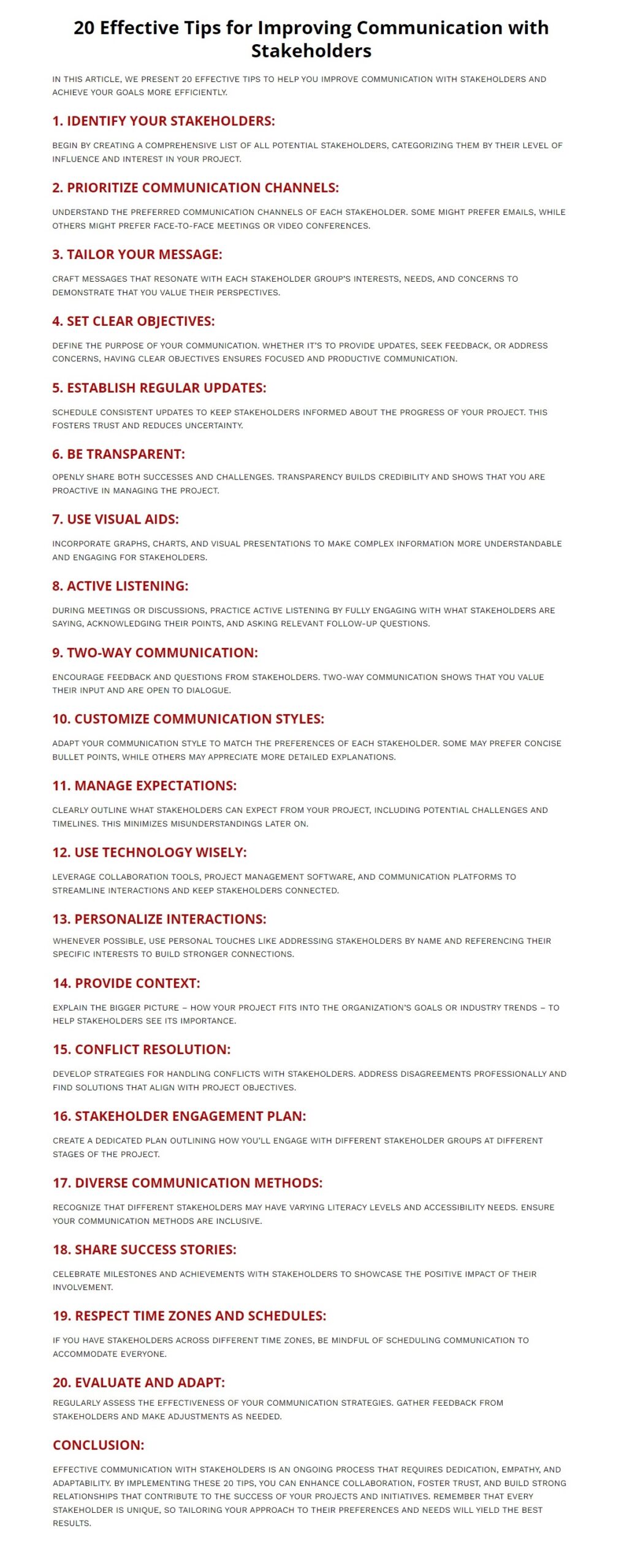 Effective communication with stakeholders is crucial for the success of any project, organization, or business endeavor. Stakeholders, who can be anyone with an interest in or influence over your project, range from clients and employees to investors and community members. Enhancing communication with these diverse groups can lead to better collaboration, increased transparency, and stronger relationships. In this article, we present 20 effective tips to help you improve communication with stakeholders and achieve your goals more efficiently.
Effective communication with stakeholders is crucial for the success of any project, organization, or business endeavor. Stakeholders, who can be anyone with an interest in or influence over your project, range from clients and employees to investors and community members. Enhancing communication with these diverse groups can lead to better collaboration, increased transparency, and stronger relationships. In this article, we present 20 effective tips to help you improve communication with stakeholders and achieve your goals more efficiently.
1. Identify Your Stakeholders: Begin by creating a comprehensive list of all potential stakeholders, categorizing them by their level of influence and interest in your project.
2. Prioritize Communication Channels: Understand the preferred communication channels of each stakeholder. Some might prefer emails, while others might prefer face-to-face meetings or video conferences.
3. Tailor Your Message: Craft messages that resonate with each stakeholder group’s interests, needs, and concerns to demonstrate that you value their perspectives.
4. Set Clear Objectives: Define the purpose of your communication. Whether it’s to provide updates, seek feedback, or address concerns, having clear objectives ensures focused and productive communication.
5. Establish Regular Updates: Schedule consistent updates to keep stakeholders informed about the progress of your project. This fosters trust and reduces uncertainty.
CLICK HERE TO DOWNLOAD 300+ PROJECT MANAGEMENT TEMPLATES & DOCUMENTS IN EXCEL
6. Be Transparent: Openly share both successes and challenges. Transparency builds credibility and shows that you are proactive in managing the project.
7. Use Visual Aids: Incorporate graphs, charts, and visual presentations to make complex information more understandable and engaging for stakeholders.
8. Active Listening: During meetings or discussions, practice active listening by fully engaging with what stakeholders are saying, acknowledging their points, and asking relevant follow-up questions.
9. Two-Way Communication: Encourage feedback and questions from stakeholders. Two-way communication shows that you value their input and are open to dialogue.
10. Customize Communication Styles: Adapt your communication style to match the preferences of each stakeholder. Some may prefer concise bullet points, while others may appreciate more detailed explanations.
11. Manage Expectations: Clearly outline what stakeholders can expect from your project, including potential challenges and timelines. This minimizes misunderstandings later on.
12. Use Technology Wisely: Leverage collaboration tools, project management software, and communication platforms to streamline interactions and keep stakeholders connected.
13. Personalize Interactions: Whenever possible, use personal touches like addressing stakeholders by name and referencing their specific interests to build stronger connections.
14. Provide Context: Explain the bigger picture – how your project fits into the organization’s goals or industry trends – to help stakeholders see its importance.
15. Conflict Resolution: Develop strategies for handling conflicts with stakeholders. Address disagreements professionally and find solutions that align with project objectives.
CLICK HERE TO DOWNLOAD 300+ PROJECT MANAGEMENT TEMPLATES & DOCUMENTS IN EXCEL
16. Stakeholder Engagement Plan: Create a dedicated plan outlining how you’ll engage with different stakeholder groups at different stages of the project.
17. Diverse Communication Methods: Recognize that different stakeholders may have varying literacy levels and accessibility needs. Ensure your communication methods are inclusive.
18. Share Success Stories: Celebrate milestones and achievements with stakeholders to showcase the positive impact of their involvement.
19. Respect Time Zones and Schedules: If you have stakeholders across different time zones, be mindful of scheduling communication to accommodate everyone.
20. Evaluate and Adapt: Regularly assess the effectiveness of your communication strategies. Gather feedback from stakeholders and make adjustments as needed.
Conclusion: Effective communication with stakeholders is an ongoing process that requires dedication, empathy, and adaptability. By implementing these 20 tips, you can enhance collaboration, foster trust, and build strong relationships that contribute to the success of your projects and initiatives. Remember that every stakeholder is unique, so tailoring your approach to their preferences and needs will yield the best results.
